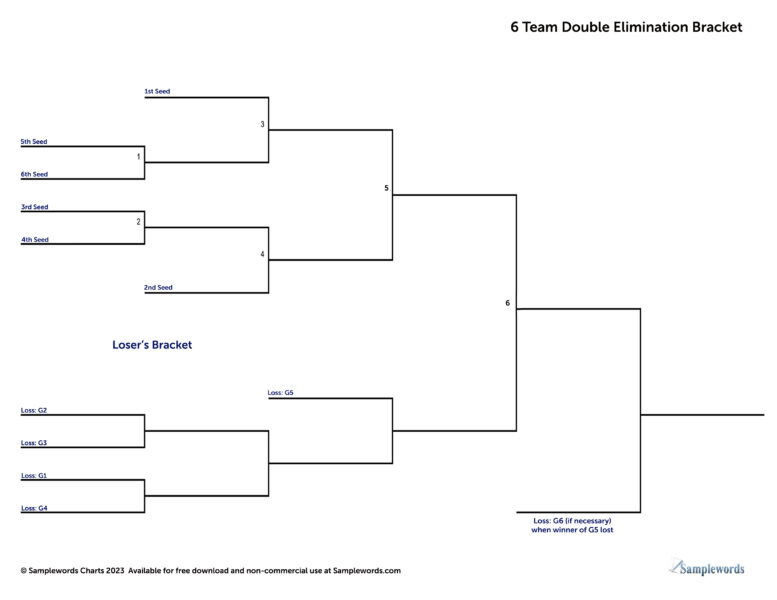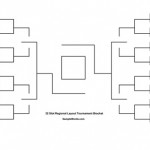6 team tournament brackets are useful in any number of sports or competitions. Brackets can be used for team sports such as baseball, softball, basketball, and can be used for individual sports like tennis, wrestling or martial arts.
The free printable tournament brackets below will be suitable to create a six team single elimination or a six team double elimination tournament. Our printable brackets are available in pdf format.
Your first step is to determine the tournament format: There are various formats you can choose from, such as round-robin, single elimination, or double elimination. Each format has its own advantages and considerations, so select the one that suits your needs and time constraints.
Format for 6 Team Tournament Bracket: Double Elimination
A six team double elimination tournament bracket is the most common format. Tournament brackets are usually single or double elimination, but the double elimination format allows for a 2 game minimum within the bracket itself. A double elimination tournament includes a loser’s bracket.
There is a minimum of eleven total games in a 6 team tournament bracket that is double elimination. A 12th contingent game is possible if the team from the loser’s bracket wins the first championship-level game and forces a second contest. The winner of each game or contest will move on to the next round and continue until the championship game is played.
Download 6 Team Double Elimination Tournament Bracket with Seeded Competitors
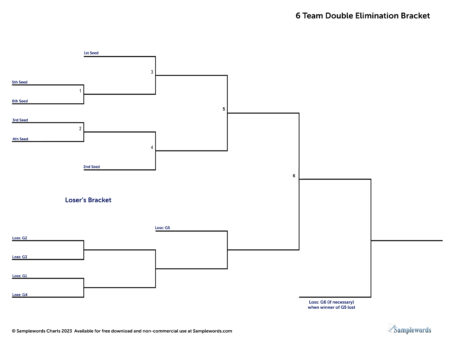
Pool Play Ranking Options for a 6 Team Tournament
Your first question is how many games or competitions do you have the capacity to play or host. For a pool play tournament involving six teams you’ll already be having at least 11 games following your ranking pool. Pool play games are usually assigned at random, and each game is between a different team (without repeating 1 on 1 games). If a tournament hosts two pool play games per team and then a double elimination tournament bracket there will be a 4-game minimum for each team and you’ll host a total possibility of 18 games. This would include six pool games and up to twelve bracket games.
Here’s an example 2-game pool play round. If you number the teams in no specific order you may have a pool schedule as follows:
Team 1 plays Team 3 and Team 5 in the pool
Team 2 plays Team 4 and Team 6 in the pool
Team 3 plays Team 1 and Team 4 in the pool
Team 4 plays Team 2 and Team 3 in the pool
Team 5 plays Team 1 and Team 6 in the pool
Team 6 plays Team 2 and Team 5 in the pool
You may also assign a Pool A of three teams and a Pool B of three teams. In this scenario both pool group teams will play a 2-game round robin competition. Read more about the structure of a sound robin tournament here.
Rankings and placements are usually determined by best to worst:
- Win and loss record
- Points allowed versus points scored, or otherwise called points differential. Overall scored minus allowed runs or points is the tiebreaker for the win/loss record.
Tournament Ranking Options Without a Pool
Determining tournament seeding without a pool involves ranking or assigning positions to teams based on their perceived strength or performance. Here are a few common methods for determining tournament seeding:
- Random seeding: This method involves assigning seed numbers to teams randomly, without considering their performance or rankings. This approach can add an element of unpredictability to the tournament.
- Head-to-head records: If the teams have already played against each other in a league or previous competitions, you can use their head-to-head records to determine seeding. The team with a better record against the other teams would receive a higher seed.
- Win-loss records: Seeding based on win-loss records is a common approach. Teams with the best overall win-loss records are given higher seeds. This method is suitable when teams have played a similar number of games against comparable competition.
- Power rankings: Power rankings take into account various factors such as team performance, strength of schedule, individual player ratings, and other relevant metrics. These rankings can be determined by sports analysts, coaches, or even statistical algorithms. Teams are seeded based on their rankings, with higher-ranked teams receiving better seeds.
- League or association standings: If the tournament is an extension of a league or athletic association by season, you can use the current standings to determine seeding. The team currently ranked highest in the standings would receive the highest seed, while subsequent teams are seeded accordingly.
Download 6 Team Double Elimination Tournament Bracket without Seeded Competitors (random placement)
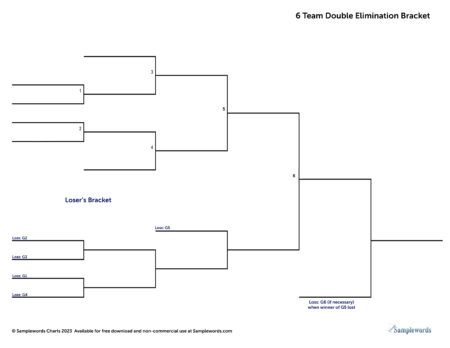
Tournament Bracket Game Sequence for Double Elimination With 6 Teams
Each team will meet a matched team in the first or second round based on how the tournament seeding has been arranged. The losers of each game from the top bracket will proceed to their position in the loser’s bracket. In our tournament bracket, the losers of Games 2 & 3 will meet in the loser’s bracket. Also, the losers of Games 1 & 4 will meet in the loser’s bracket. The loser of Game 5 will play versus the overall winner of the first four teams arriving in the loser’s bracket. Finally, the loser’s bracket winner will compete against the undefeated competitor from the top bracket.
Since this is a double elimination sports bracket, no team shall exit without losing two games or winning the tournament outright. IF the winner from the loser’s bracket should defeat the winner of the top bracket, these teams shall play a second time. The previously undefeated team from the top bracket is granted two losses before exiting, just like any other competitor in the tournament. The loser’s bracket winner then, has to defeat the top bracket winner twice in a row in order to win the tournament.
Formats for 6 Team Bracket: Single Elimination
The single elimination bracket is a far more simple tournament to set up. Whenever a team loses a game in single elimination they are eliminated from the tournament.
There are only five games held in a six-team single elimination bracket. If a tournament hosts two pool play games per team and then a single elimination tournament bracket there will be a 3-game minimum for each team and you’ll host a total possibility of 11 games.
Pool play guidelines for organizing a six team tournament bracket are the same for both single and double elimination formats. Refer to pool play options above for a complete reference.
Download 6 Team Single Elimination Tournament Bracket with Seeded Competitors
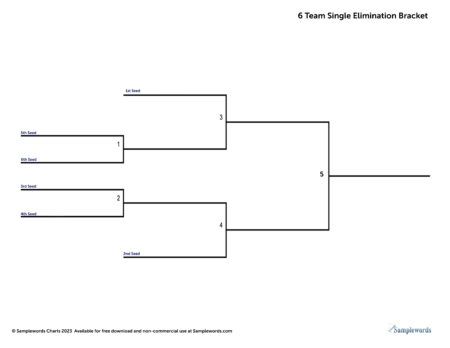
There will be five games only for a 6-team single elimination tournament without prior pool games or a ranking round. As many as four teams may only play a single game before exiting the tournament. This single elimination format will only be a one-game guarantee, and the maximum number of games any team can expect to play is three.
Remember to communicate the schedule and bracket to all participating teams, officials, and spectators before the tournament begins. This will ensure everyone is aware of the matchups and can follow along with the tournament progress. Communication is important in a brief tournament format like this. Teams that travel greater distances will prefer a format that entitles their team to play several games.
Download Simple 6 Team Single Elimination Tournament Bracket Without Ranked or Seeded Competitors
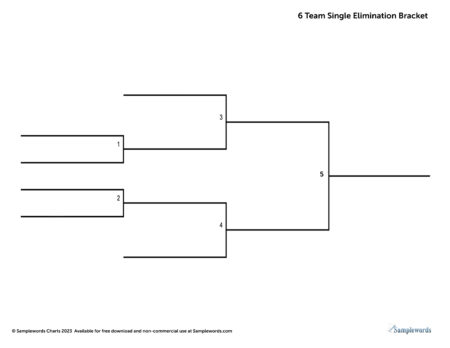
Additional Tips For Planning a Tournament
Decide on the dates and times for the matches. Consider factors like availability of teams, venues, and any other constraints that may impact the schedule. Ensure that there is ample time between matches for teams to rest and prepare. Each format has its own advantages and considerations, so select the one that suits your needs and time constraints based on the number of games your tournament can handle and are also reasonable for teams and players to complete within the allotted time.
Always define the tournament rules, including game rules, match duration, tie-breakers, and any specific regulations relevant to the sport. Communicate these rules to all participating teams, officials, and spectators to ensure a fair and enjoyable tournament. Allow teams to confirm their participation and address any questions or concerns they may have. Brackets and schedules should be released as far ahead of time as possible to ensure that all teams and competitors have adequate time to prepare.
View all of our tournament brackets here.

